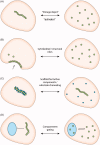Metabolic regulation via enzyme filamentation
- PMID: 27098510
- PMCID: PMC4915340
- DOI: 10.3109/10409238.2016.1172555
Metabolic regulation via enzyme filamentation
Abstract
Determining the mechanisms of enzymatic regulation is central to the study of cellular metabolism. Regulation of enzyme activity via polymerization-mediated strategies has been shown to be widespread, and plays a vital role in mediating cellular homeostasis. In this review, we begin with an overview of the filamentation of CTP synthase, which forms filamentous structures termed cytoophidia. We then highlight other important examples of the phenomenon. Moreover, we discuss recent data relating to the regulation of enzyme activity by compartmentalization into cytoophidia. Finally, we hypothesize potential roles for enzyme filament formation in the regulation of metabolism, development and disease.
Keywords: CTP synthase; IMP dehydrogenase; cytoophidium; intracellular compartmentation; metabolism.
Figures



References
-
- An S, Kumar R, Sheets ED, Benkovic SJ. Reversible compartmentalization of de novo purine biosynthetic complexes in living cells. Science. 2008;320:103–6. - PubMed
Publication types
MeSH terms
Substances
Grants and funding
LinkOut - more resources
Full Text Sources
Other Literature Sources
